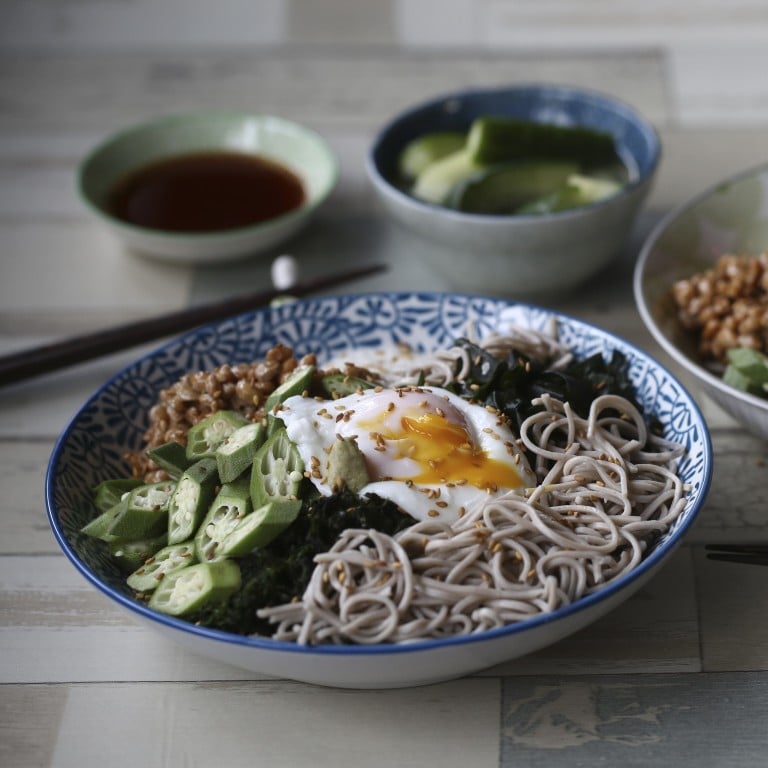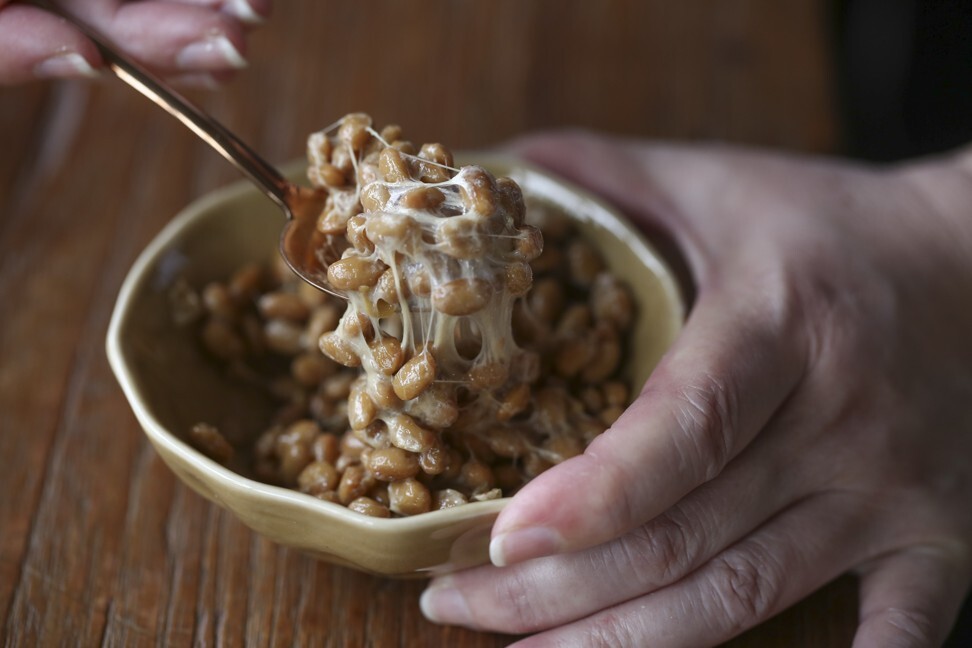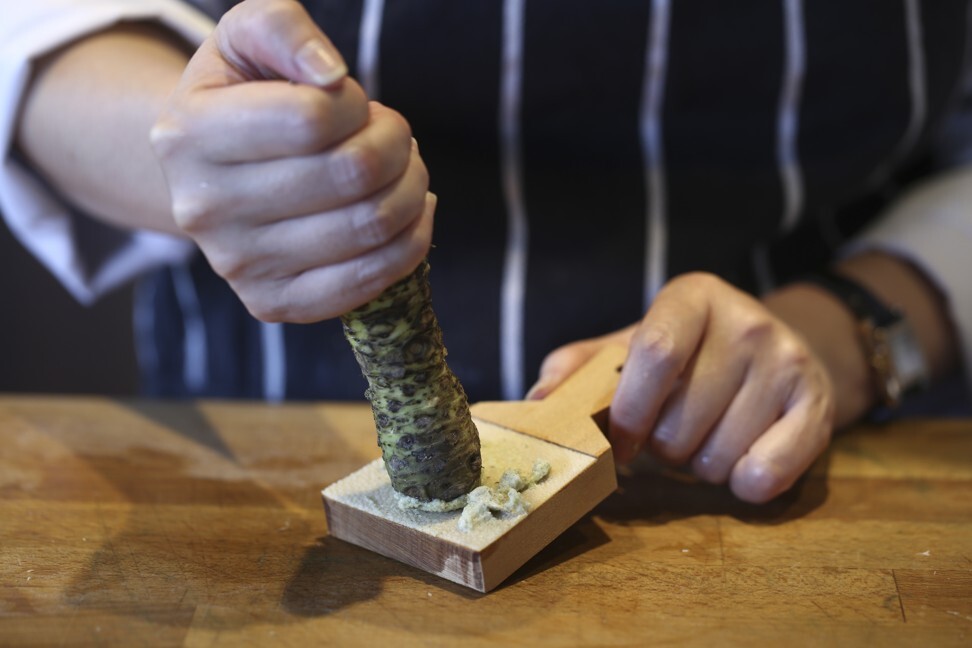
How to make Japanese cold noodles – vegetarian neba-neba soba to beat the heat
- This meat-free version of buckwheat noodles is deliciously slippery rather than slimy
- Add or substitute ingredients as you wish – a vegan option is easily achieved by leaving the egg out
The Japanese have created delicious and refreshing ways to beat the summer heat. One of my favourites is cold noodles, which can be served in a variety of ways. Most people are familiar with soba (buckwheat flour noodles) or somen (noodles made of wheat flour) served with a bowl of ice-cold dipping sauce mixed with minced spring onion and grated wasabi or ginger.
But there’s far more besides: the noodles can be flavoured with sakura (for a pretty pink tinge), yuzu (pale yellow) or green tea, and there are other cold noodle dishes such as hiyashi chuka (cold ramen noodles with ham, imitation crabmeat and lots of vegetables).
One of my favourite cold noodle dishes is a vegetarian version I first tasted at a soba restaurant in Hong Kong. It might not sound appetising, because it has ingredients that many people avoid – natto (fermented soybeans), grated mountain yam (yamaimo or nagaimo), okra and onsen egg, all of which have a slimy texture that the Japanese describe as neba-neba – but the combination is delicious. When mixed with soba noodles, these ingredients give the dish a pleasantly slippery texture.
Natto is a healthy, protein-rich ingredient sold in small packs in the refrigerated section of supermarkets. To increase the sticky character, stir the natto with chopsticks until you can see long strands when you lift the soybeans.
Susan Jung’s Japanese cold noodles with dipping sauce
Soba noodles often come portioned into small bundles convenient for cooking. One bundle – about 90 grams – should be enough for one person, but if you have a large appetite, you might want three bundles for two people.
This dish is versatile and you can add, subtract or substitute other ingredients as you wish. If you are vegan, omit the egg: I use poached rather than onsen eggs, also called 63-degree eggs because that’s the temperature at which they are cooked.
I sometimes add boiled, podded edamame (soybeans) and/or sliced radish, julienned carrot or fresh daikon, or other vegetables. If you can’t find fresh wasabi (which is expensive) use grated ginger instead (wasabi paste and powder are too strong).
Neba-neba soba is often drizzled with mentsuyu, a strong dipping sauce, either home-made or purchased (you’ll find it in bottles near the dried noodles). Most of these contain katsuobushi, or shavings of dried and fermented skipjack tuna, but vegetarian versions are also available. Be sure to check the ingredients label.
Neba-neba soba (buckwheat noodles with natto, mountain yam, okra and soft-centred egg)
2 bundles (about 90 grams each) soba noodles
5 grams wakame (dried seaweed)
6-10 okra pods
2 45-gram packs of natto
100 grams mountain yam (yamaimo or nagaimo)
Fresh wasabi or ginger
2 eggs, at room temperature
5ml white vinegar
A small handful of shredded nori
About 60ml mentsuyu (soba noodle dipping sauce)
Toasted sesame seeds

1 Bring a large pot of water to the boil, add the soba and cook until firm-tender. Drain, rinse with cold water, then drain again. Put the noodles into a large bowl filled with iced water.
2 Briefly rinse the wakame, then put it in a bowl, cover with cool water and leave to soak for five minutes – it expands a lot. Drain it, then squeeze out the excess water.
3 Cut the okra pods on the diagonal into slices about 5mm thick.
4 Stir the natto until it forms long strands.

5 Peel the mountain yam, then grate it (preferably using a Japanese ceramic oroshigane) into a fine, sticky pulp. If using fresh wasabi, peel away just enough skin to expose what you’ll need for immediate use (the flesh darkens when exposed to air).
Grate the wasabi, preferably on a sharkskin grater or ceramic oroshigane, until you have about 1½ teaspoons’ worth. If using ginger, peel it, then use the ceramic oroshigane to grate about 1½ teaspoons’ worth.
6 Bring a medium-sized pot of water to the boil, lower the heat to a low simmer, then stir in the white vinegar. Crack one egg into a small dish. Use a spoon to stir the water to create a vortex, then add the egg into the middle of the vortex. Continue to stir the water, taking care not to break the egg.
Cook the egg for one minute, or until the white is softly set and the yolk is still runny, then use a slotted spoon to remove it from the water before placing it on a paper towel. Poach the remaining egg the same way.

7 Drain the soba noodles in a colander, shaking off the excess water. Divide the noodles between two plates or shallow bowls.
8 Divide the wakame, okra, natto, mountain yam and shredded nori between the plates, putting each ingredient in a separate pile. Divide the wasabi or ginger into two portions and shape each one into a small cone. Add one to the side of each plate.
9 Place a poached egg on top of the noodles, in the centre. Sprinkle with toasted sesame seeds, then serve the noodles with small bowls of mentsuyu.

10 Drizzle the mentsuyu over the noodles and use chopsticks and a spoon to mix all the ingredients together before eating.

